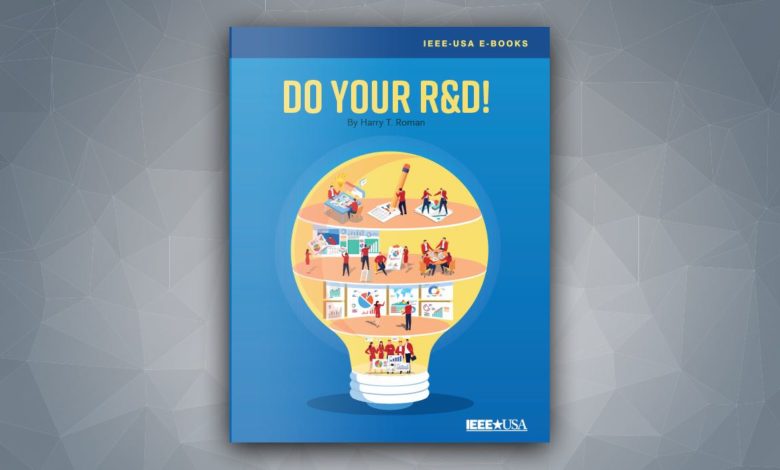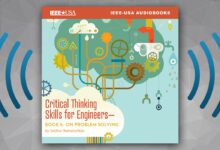
At last! After publishing more than 550 scientific papers, articles, monographs and books on a wealth of topics for engineers, Harry T. Roman has written an e-book about the discipline where he devoted most of his career: research and development, or R&D.
This IEEE Life Senior Member, veteran engineer and educator believes more technical professionals, at all levels, need to enhance their appreciation of R&D — risks and all. Despite it being an expense that can be difficult to quantify — especially in difficult economic times — he believes R&D is nothing less than “technological due diligence.”
Roman’s credentials are self-evident. He worked for 36 years in R&D for PSE&G, New Jersey’s largest utility company. Over the decades, he directed and consulted on more than $100-million worth of projects and programs.
Jam-packed with worthwhile insights and observations that Roman gained through hands-on experience, IEEE-USA is publishing, Do Your R&D! The volume is available beginning 1 October through the IEEE-USA Shop — free to all IEEE members. Non-members pay $2.99.
“R&D is powerful stuff — the lifeblood of new product development and the groundwork for what we consider technologically driven progress,” Roman writes. He points to major companies like Du Pont and 3M, both noted for continuous innovation over long periods of time. However, he also notes that “the business end of a company can have serious doubts about just what needs to be done and financed though R&D.”
Roman urges, “To do R&D right, you must know where you are going and why; and what technologies you intend to use to get there. It’s part of the strategic planning process, using the intellectual property and specialized knowledge the organization possesses to project its competitiveness into future markets.”
In a chapter that provides an overview of R&D expenditures worldwide, Roman writes that in 2020, the United States has spent more than $553 billion — thus leading the top five nations. China was in second place, having spent more than $475 billion.
Samsung has been the top company spending R&D in 2020, having spent $14.9 billion.
Alphabet, at $14.8 billion; and Volkswagen, at $14.5 billion, round out the top three companies spending big bucks for R&D in 2020.
Roman notes that one can observe the urgency or intensity with which a nation spends R&D funds by looking at the percentage that R&D funding is to a nation’s economy [GDP]. “Obviously, these numbers change from year to year; and the amount of R&D intensity also varies year to year, among major industries,” he wrote. “Industrial R&D expenditures are likely to reflect the nature of the industry and its competitiveness. For instance, in the utility industry, the intensity [measured as a percentage of revenue] is probably less than one percent; while in the pharmaceutical business, it can be well over 20 percent. The national average for all industries is about 3.5 percent.”
As for the R&D process itself, Roman outlines it in seven key steps:
- Identify a problem worth solving.
- Evaluate the economics/marketing needs.
- Identify constraints, impacts, challenges.
- Identify and test potential solutions.
- Validate intention against steps 1, 2 and 3.
- Market the invention.
- Improve and grow the invention.
The author points out that this inevitably team-based effort is both self-repeating and easy to understand. He adds that invention is “designing with constraints — for the social, environmental, legal and regulatory impacts of the new product on the modern world must be given the same identity.”
Roman devotes a chapter of his new e-book to the ever-present concerns of R&D and risk. After all, research and development are difficult to manage, since the essential feature of research is that the researchers do not know in advance exactly how or even whether they will accomplish the desired result. Further, and as a result of this uncertainty, higher levels of R&D spending do not guarantee a more innovative product, higher profits, or a greater market share.
The author writes, “Since the future contains all sorts of uncertainty, we conduct R&D to narrow down that uncertainty into portfolios of risk we are able to understand, and concentrate corporate resources upon. This connects senior management to future dreams tempered with quantitative analysis and realistic odds for success.”
Roman points out that the R&D budget cuts following the 1996 deregulation of the telephone industry were soon followed by budgets many times greater than before deregulation. The lesson here is obvious: the more competition there is, the more the need for R&D.
“Companies become great because they have the courage to establish a vision of the future, and then pursue that vision with passion and determination,” he says. “Great companies dream first, and then plan on how to get the funds to accomplish their goals.”
Throughout Do Your R&D!, Roman credits Thomas Edison with originating the process of invention — systematizing the steps in developing a raw idea into a commercial product. A lifelong devotee of the great inventor, Roman believes Edison’s concepts later evolved into what we now recognize as today’s team-based R&D that is ubiquitous throughout industry, academe and government.
Describing his historic laboratories in West Orange, New Jersey, as an “epicenter of creativity and invention that was the heart of Edison’s evolutionary enterprise,” the author observes that the inventor also realized the importance of having a multitude of talents and skills on hand — from lawyers to marketers — to bring ideas from concept to market.
“Codifying the R&D process is Edison’s greatest invention,” he states.
Helen Horwitz is an award-winning freelance writer who lives in Albuquerque, N.M. She was with IEEE from 1991 through 2011, the first nine as Staff Director, IEEE Corporate Communications.






